Intimate Justice: GLAMHAG
“Intimate Justice” looks at the intersection of art and sex and how these actions intertwine to serve as a form of resistance, activism, and dialogue in the Chicago community. For…
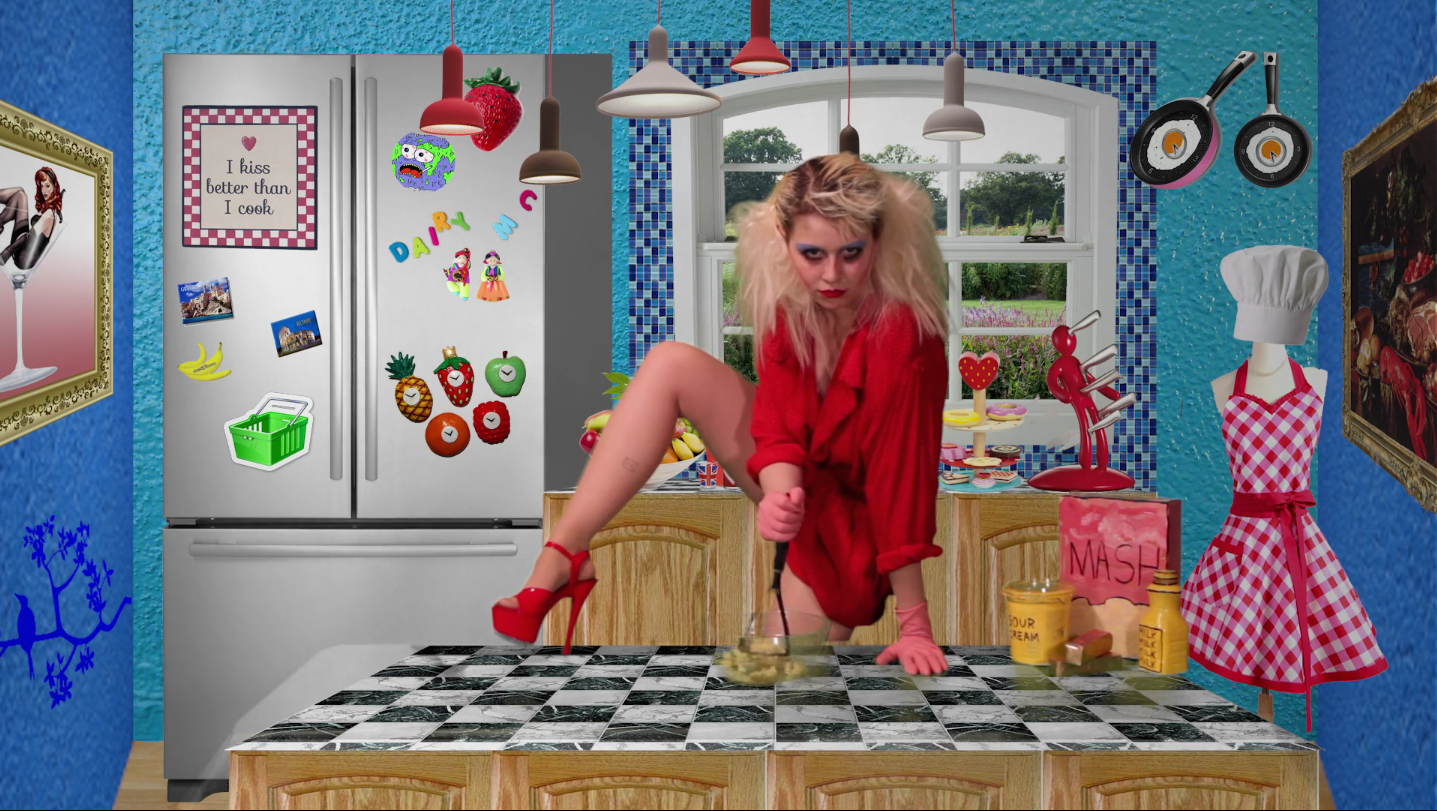
“Intimate Justice” looks at the intersection of art and sex and how these actions intertwine to serve as a form of resistance, activism, and dialogue in the Chicago community. For this installment, we talked to GLAMHAG (née Molly Hewitt) in the Pilsen neighborhood about compulsions, empowerment through a chosen identity, and queer sexual narratives.
S. Nicole Lane: What does performance mean to you? Are you always in character? Who are you right now?
GLAMHAG: I guess I’ve always been compelled to perform in my work, whether that’s live performance or in my video work. I think it’s really a compulsion. I do feel that with the kind work I’m making, communicating with my body when it’s so much about my body—other bodies—and sexuality, using my body makes the most sense.
I do definitely have a compulsion to perform. And then I also do things that come along with a lot of other performers too, I definitely have exhibitionist tendencies. I like attention.
SNL: Where are you from originally?
GH: I’m from England originally, I was born in London. I moved to LA when I was thirteen, then I came to Chicago eight years ago.
SNL: And did you study performance in school?
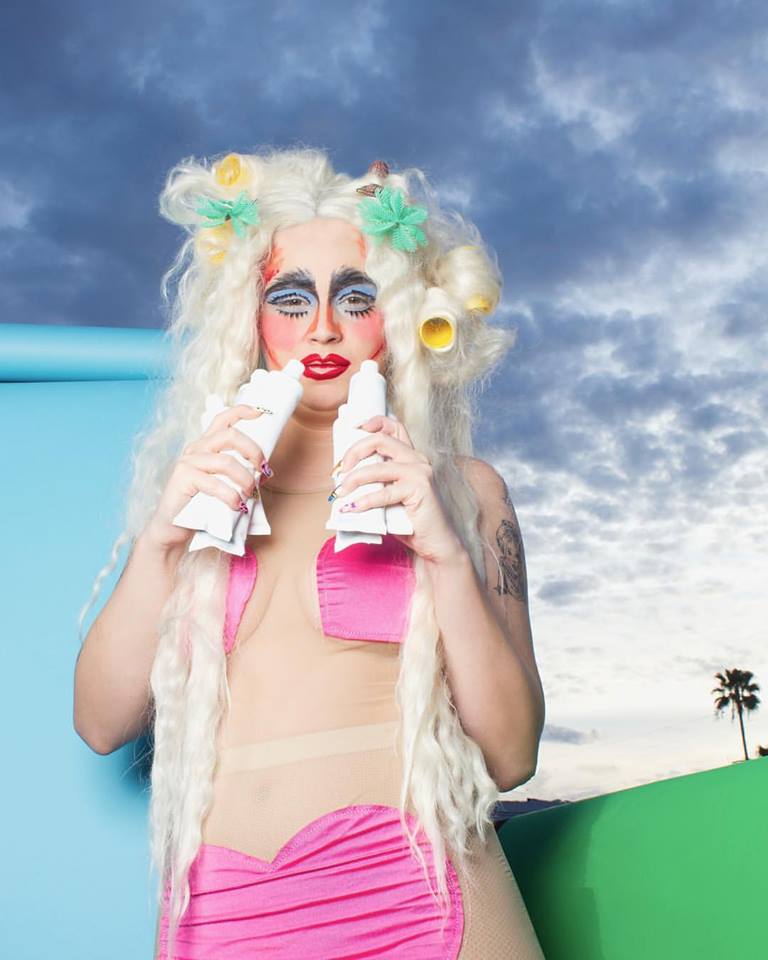
A vertical image of a figure with long black long hair is holding several tubes with dramatic makeup on. In the background is the sky, a palm tree, and green and blue back drops. Photo by Danin Jaquay.
GH: Yeah, I did a lot of different things. I studied ceramics and fibers and some performance and video, and kind of ended up doing a mixture of all those different things.
SNL: And you still work with sculpture now, correct?
GH: Yeah, I make a lot of objects that end up being props in videos.
SNL: Okay. Can you talk about the difference in creating 3D sculptural objects compared to video and how that process is different?
GH: I actually don’t know if I really ever make anything that doesn’t end up being a prop for a video or something to be used in a performance. I feel like whenever I make something it’s with the intention of using it for something. And then it obviously exists as a prop or a piece, once it’s activated. Once it’s been used in a performance, and it’s dirty, or it’s broken, and it’s been used, then it’s more of an artifact or a relic of something.
SNL: I feel like I’ve been talking to a lot of people about relics lately. I was talking to Fran, a musician, on Sixty and she said that her songs were relics of an emotion that she may have felt years ago and now it doesn’t feel that way anymore.
GH: It’s funny, because I feel like I’ve definitely used the word artifact, but I don’t know if I’ve ever used the word relic until right now.
SNL: I recently read this article in The New York Times about monsters and their place in the queer art scene. It detailed what the Frankenstein story means for the queer art community. It got me thinking about the themes of monsters or characters, in performance, in costume, and dressing up. What archetypes sort of stick out to you in performance specifically for GLAMHAG?
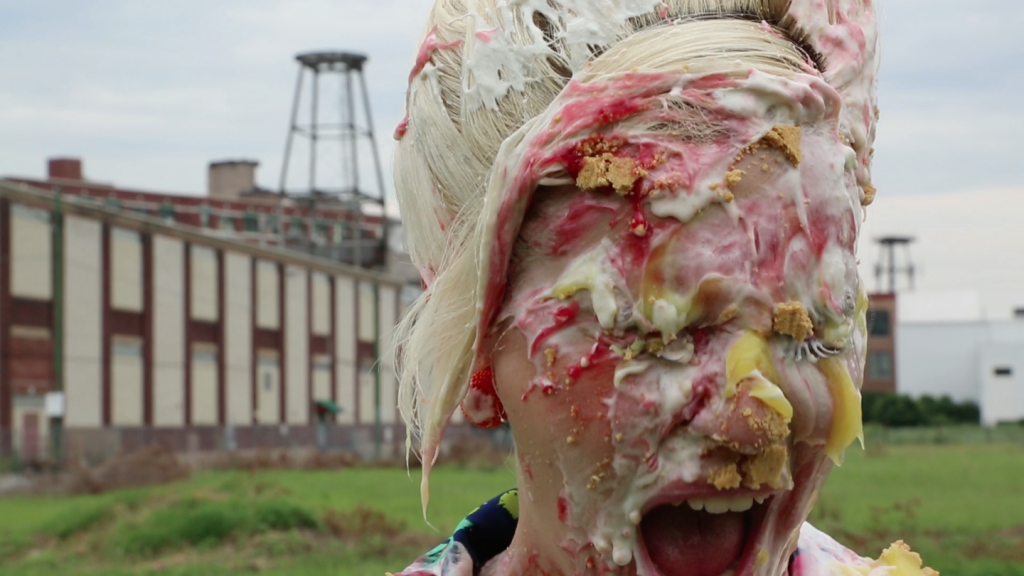
GLAMHAG, still from “Cherry, Lemon, Pumpkin.” A horizontal photo with a figures head on the right side of the image. The figure is covered in pink, yellow, and white food. Their mouth is open. Image courtesy of the artist.
GH: Yeah. I definitely explore my own gender identity when I’m performing as this very, at times, neutral but very fluid person. Sometimes I do very masculine drag and sometimes it’s very feminine, but a lot of the time it just feels like I’m this grotesque monster. Or being a creature or a thing, instead of masquerading as this specific binary gender. I guess a monster would probably be a grotesque and scary creature. It’s something that’s very much othered or not normal or considered repulsive because it’s not confining to standard beauty, or beauty standards. In that sense I really relate to being a monster. I also feel like just being perceived as a pretty girl, I get treated a certain way when I walk around the world, and so it does feel really nice to put on this mask and make myself unappealing in those ways, because then it feels really empowering for me. I actually do feel really sexy and beautiful when I’m painting on a gap tooth and gluing oatmeal to my face, right? Because it’s how I want to look. I also have had some monster characters in some of my pieces. It starts off as just something that I’m drawn to aesthetically and then afterwards it’s like, “Oh yeah this is definitely like a queer narrative.”
In my short film, “Maggie’s Problem”, the main character is cheating on her husband with a sea monster. At first I was just making a campy weird film—I’m particularly drawn to nautical aesthetics—but then I realized that it was totally about discovering your queer sexuality narrative.
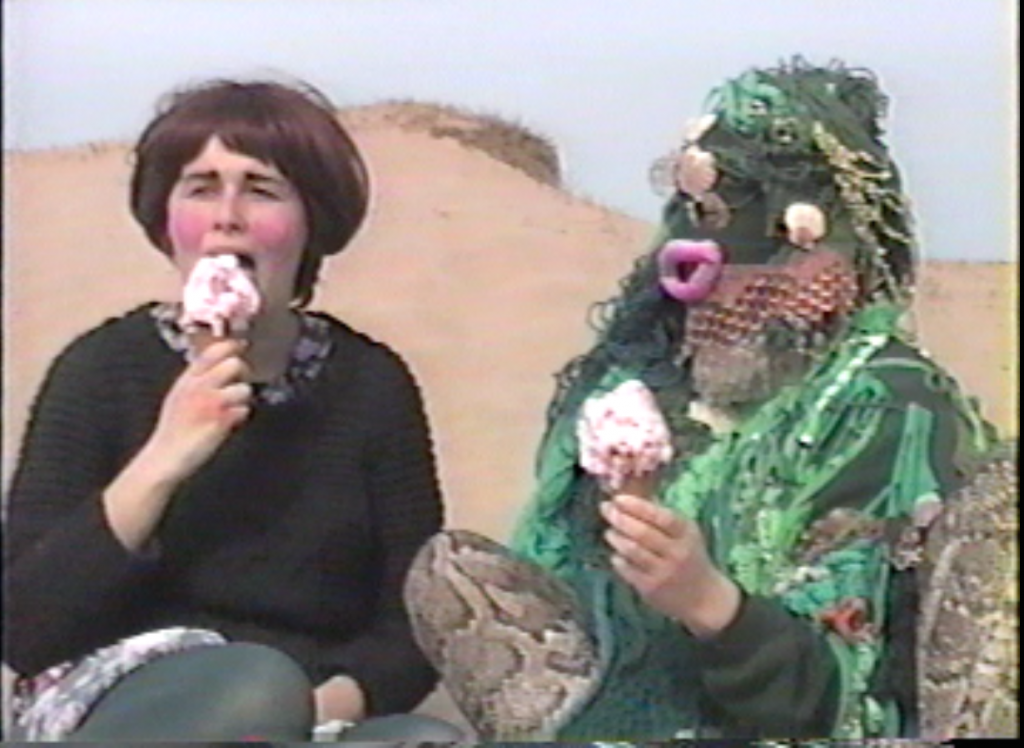
GLAMHAG, still from “Maggie’s Problem.” Two figures sit down eating ice cream. The right hand figure is dressed up like a sea monster with pink lips and a green costume. Image courtesy of the artist.
SNL: Have you performed in front of other people, or is it mostly just in film?
GH: Yeah, I do perform a lot. What I do can exist in a lot of different formats. I can perform at shows with bands, or at comedy shows, or at drag shows, or performance shows. I’m always kind of slightly off, or the odd one out. I’ll alter what I’m doing to fit a little more into those categories. I think that comedy ends up working best. Or performance art shows. I think just because of the amount of attention that people are giving to the performers. My work is always funny. It’s also always fun for me because it’s a little bit too weird and uncomfortable. It’s not stand-up or something.
SNL: Right, yeah. Can you talk about incorporating humor in your work, and where that comes from?
GH: I have always done that. I’ve never really made anything that’s just serious, that’s not funny. But I also feel that humor is the most universal language, and I think it’s the best way to communicate with people. It’s a really good way to communicate really serious and dark and upsetting things because you can access somebody quickly and get them closer to you by using humor and make them start thinking about what they’re laughing at. I think I have a lot of moments in my videos where I want people to be laughing, and then stop and be like, “Wait, what am I actually laughing at right now?”
SNL: It’s like you’re laughing at the performer and then maybe it goes on for too long, whatever the act may be, and then you kind of become worried for the performer or your mood switches and you’re like, “What’s going on? Am I supposed to be laughing at this?” But that’s what’s so great about performance. It takes you on a roller coaster.
GH: There’s that really specific timing in the cycle where it’s funny, and then it’s awkward, and then it’s funny again because of the exact amount of time that it’s been going on too long, and then it’s awkward again and then it’s funny again. It’s this cycle of a really specific amount of time that seems to be a thing.
SNL: Can you talk about film Holy Trinity a little bit?
MH: Yeah. I’ve been writing it for a few years, and it started off more about different kinds of spiritual experiences one can have. It’s about looking at the similarities between different religions, and comparing my own experiences with things like sex, play, and drugs. And dancing and partying, and people. How that was my experience with religion and spirituality, and how that’s not really considered valid. And thinking about how Christianity kind of ruined everything and how this country was founded on such puritanical roots. It’s really stunted or altered our inherent knowledge about spirituality that I think we all have.
I wrote characters, mainly people that I’ve met in Pilsen, into the script.
It’ll be shot all over Chicago. We haven’t location scouted all of the areas yet. We’re going to be creative, like the world is going to be like Chicago in an alternate universe, or Chicago through a funhouse mirror. It’s based on my experiences in Chicago, but it’s going to be very stylized.
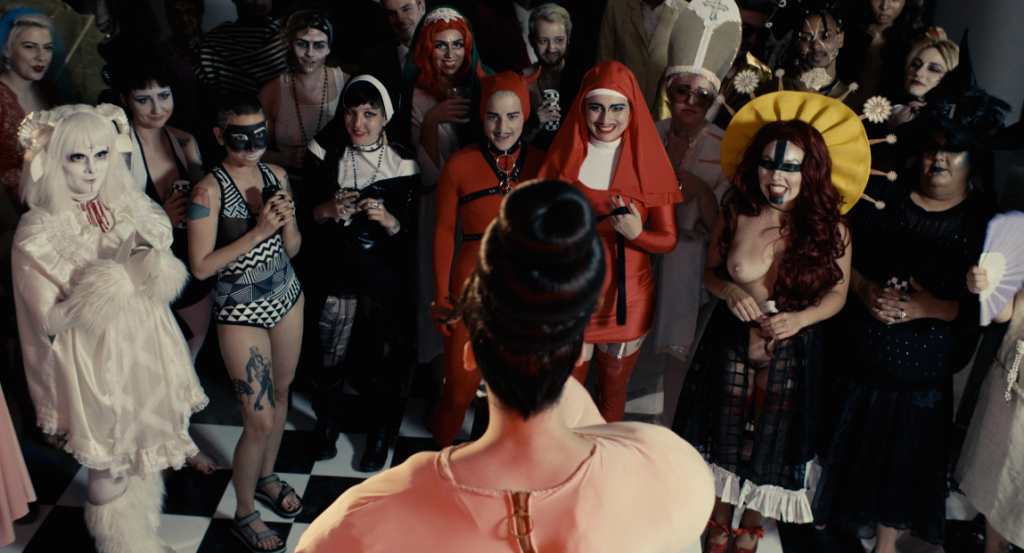
GLAMHAG. Still from “Holy Trinity.” A group of people dressed up in costumes are smiling at the figure on stage who is facing away from the viewer. Image courtesy of the artist.
SNL: Yeah. Can you expand on how the film will tackle how kinky/queer people are stigmatized, and maybe touch on the stigmatization of those certain things?
GH: Yeah. It’s funny because sometimes I feel like I definitely do live in a bubble, and so much my world, that I don’t consider those things weird anymore. You step outside your bubble for a second and realize that that stuff is still incredibly taboo, and even though it’s things that have been explored by people, different sexualities have always been around for decades in an open and public way, it’s still so stigmatized. I do feel like now, certain aspects of kink and BDSM have gotten trendy. But it’s still a very real thing for people, and I think the lead role, in terms of different power dynamics that we engage in, and different situations that we put ourselves in, I feel like my own performance practice, I definitely have my compulsion to perform and the things that I do and the situations that I put myself in, I don’t necessarily always know why I’m doing it. I’m fulfilling some kind of life need for whatever. I think that’s tied into sexual desires for sure. I think mainly what I want to do with this movie is have the characters be queer, trans, kinky people, but it’s not about that. It’s about them going on a spiritual journey, or them just living their lives, and they just happen to be queer people.
We’re definitely seeing more queer narratives, but it’s always about this struggle, it’s about them being queer. Even in gallery shows or screenings, it’s like, “This is a show about gender and sexuality. This is a show about exploring the non-binary blah blah blah.” How about we have a show that’s about literally anything else and then make all of the artists queer? But then not say that.
I’m telling my own story but I am also including all of these narratives that aren’t mine. And I don’t understand what it’s like to be these people and I’m not going to use their experiences, I would rather just let them [tell it]. They’re going to be collaborating and doing that part for me.
SNL: Who are you collaborating with?
GH: Imp Queen is playing Trinity’s roommate. Heather Lynn is playing Trinity’s other roommate. They’re both performers, artists living and working in Chicago and also two of my close friends. Èfren is playing the reiki practitioner. They are an actual reiki practitioner working in Chicago. I also have Laura Gonzalez who is an actual tarot reader and a witch.
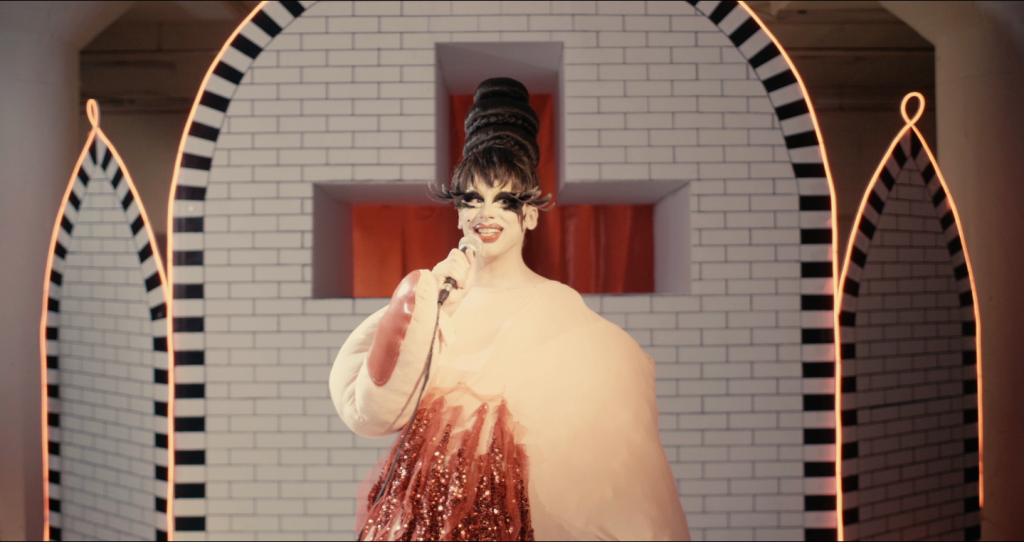
GLAMHAG. Still from “Holy Trinity.” Imp Queen is seen wearing An Authentic Skid Mark’s costume. Behind the figure is a church-like set and a cross. Image courtesy of the artist.
Also I’m not sure—there’s a hundred people who will end up in the film. All of the performers that were in the drag scene church, they’re all performers, drag artists, comedians who are living and working in Chicago who I just wanted to feature.
SNL: Do you work in a studio?
GH: Yeah. I live in an old punk house. The first floor was turned into a white wall gallery a few years ago, and we just ended up turning it into a studio. It has a basement that is now a little green screen studio. So yeah, I live in… this sinking Victorian house. It’s slanty and a little bit crusty. So I do have a pretty big studio.
I don’t think I’m ever really not working on stuff. Sometimes it’s a bit much. I do really like it, but sometimes it’s like the moment I wake up until the moment I go to sleep, and it’s a lot. But it’s also like I help people out with their stuff, so sometimes I’m working on other people’s projects too. Yeah, sometimes it’s just thinking about stuff.
SNL: Chicago’s nightlife has obviously really influenced your work. Can you talk about that influence and maybe how Chicago has really impacted the way you think about performance?
GH: Yeah! I think Chicago is really unique, in the DIY scene and the performance scene here. It’s really open and welcoming and it’s not difficult to break into it. If you want to perform, you can. People are always really willing to engage everybody and give people a fair shot at performing. I think people should get paid but there are a lot of DIY shows where the spirit is more celebrated, and the fun is in performing, and it’s not super money-oriented. I don’t know, it always seems like there’s something a little bit different and special about Chicago.
SNL: Yeah, definitely. I agree. I’ve written a lot about the Chicago nightlife in general. It’s very magical I think. We’re in between these two cities and kind of feel like the underdog, but we know that we’re also better in this way, and have all this amazing stuff going on. And everyone is so close and really intimate with one another. This column kind of started out after Trump was elected, I was thinking about how artists are coping and I was thinking about how as a writer, who primarily writes about sex, and I felt like all of a sudden my job was more important than it was before. I just felt like I needed to continue talking about it, so then I started thinking about how artists are coping, or if they view their work as a form of resistance, especially people who are making a sexually charged work, or work that deals with intimacy and desire. What are your thoughts on that, and do you view your work in that way?
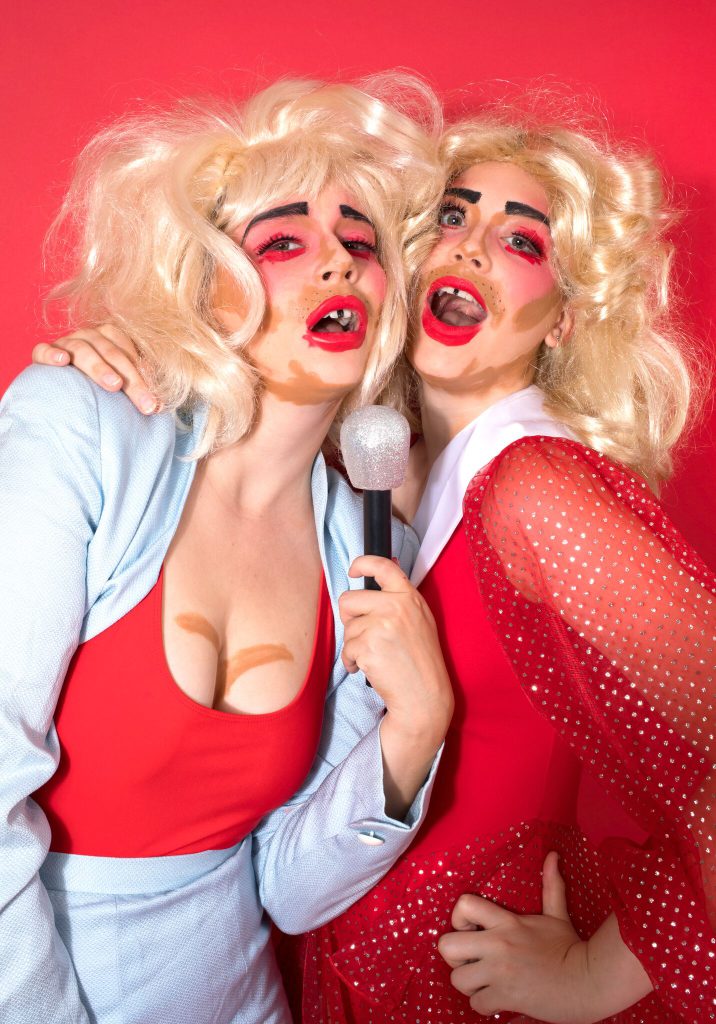
Dora Hewitt and the artist are posed with in front of a red background with red dramatic makeup on. They have gaped teeth and are singing into a prop microphone. Photo by Danin Jaquay.
GH: Yeah, I agree with you, I think definitely things really changed, and it definitely became much more of this feeling of necessity and resistance. I feel like making work is going to be what keeps us afloat. Continuing to make this art to prove that we exist and to maintain visibility is super important. Just to make a lot of noise.
I really relate to what you’re saying, and I feel like it looks like the movie idea suddenly became a lot more serious. The movie that I’m making is really going to not be that crazy. It’s going to have some sex scenes in it, it’s going to be a little bit explicit, but it’s not like it’s anything people have never seen before. But I feel like we’ve gone so backwards that it’s kind of being received like it is this super radical crazy thing, but it’s really not that crazy.
Featured Image: GLAMHAG, still from on-going collaboration with artist Paula Nacifs. A figure is popped up in high heels on a checkered counter. The figure is in a kitchen, with pots, pans, an apron and a fridge. Image courtesy of the artist.
 S. Nicole Lane is a visual artist and writer based in the South Side. Her work can be found on Playboy, HelloFlo, Rewire, SELF, and other corners of the internet, where she discusses sexual health, wellness, and the arts. Follow her on Twitter.
S. Nicole Lane is a visual artist and writer based in the South Side. Her work can be found on Playboy, HelloFlo, Rewire, SELF, and other corners of the internet, where she discusses sexual health, wellness, and the arts. Follow her on Twitter.
